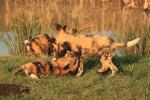Painted Dogs
The African wild dog, also called Cape hunting dog or painted dog, roam the open plains and sparse woodlands of sub-Saharan Africa. They live in packs that are usually dominated by a breeding pair. The female can have a litter of between 2 to 20 pups, which are cared for by the entire pack. They are cunning and ferocious hunters and the fittest dogs can catch their prey 80% of the time probably aided by their excellent eyesight. These dogs are very social and packs have been known to share food and assist weak or ill members. Social interactions are common, and the dogs communicate by touch, actions, and their high pitched yapping calls.
These long-legged canines have only four toes per foot, unlike other dogs, which have five toes on their forefeet. The dog's Latin name means “painted wolf,” referring to the animal's irregular, mottled coat, which features patches of red, black, brown, white, and yellow fur. Each animal has its own unique coat pattern, and all have big, rounded ears.
African wild dogs hunt in formidable, cooperative packs of 6 to 20 animals. Larger packs were more common before the dogs became endangered. The packs hunt antelopes and will also tackle much larger prey, such as wildebeests, particularly if their quarry is ill or injured. The dogs supplement their diet with rodents and birds. As human settlements expand, the dogs have developed a taste for livestock, though significant damage is rare. Unfortunately, they are often hunted and killed by farmers who fear for their domestic animals. African wild dogs are threatened by shrinking space to roam in their African homeland.
The dogs pictured below were born at the Yorkshire Wildlife Park in Doncaster. A litter of 7 painted dog puppies were born in November 2016. Although they had a purposeful house the parent dogs used their natural instincts to dig their own den in order to give birth to the puppies in their own underground shelter. These births are particularly significant after a sharp decline in Painted Dog numbers in the wild. In the past decade, wild populations have dropped from 500,000 to 5,000.
|








